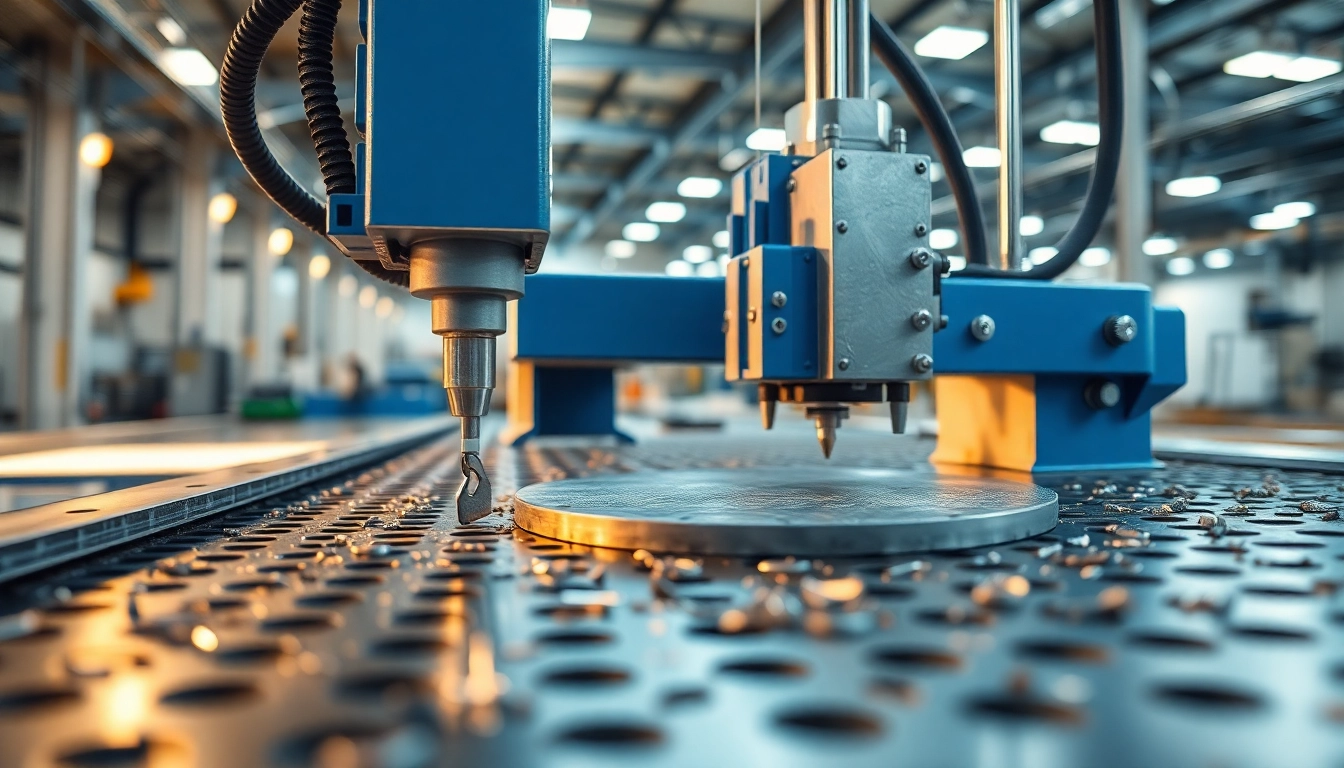Understanding Precision Die Cutting
What is Precision Die Cutting?
Precision die cutting is a manufacturing process that utilizes specialized dies to cut materials into specified shapes and sizes with exceptional accuracy. This technique is particularly valuable in industries that require high levels of detail and uniformity in production, such as packaging, automotive, and electronics. Unlike traditional cutting methods, which can be limited by the skill of the operator or the capabilities of the equipment, precision die cutting leverages automated machines that minimize human error and maximize efficiency.
The process can handle a wide variety of materials, including plastics, paper, rubber, and even metals, enabling a diverse range of applications. Quick setups and high-speed production make it an ideal choice for both small and large scale manufacturing runs. For businesses looking to enhance their manufacturing capabilities, precision die cutting offers a solution that combines innovation with practicality.
The Importance of Precision in Die Cutting
The hallmark of precision die cutting is its accuracy. The ability to produce parts that conform to strict tolerances is critical in many applications. For instance, in the automotive industry, component parts must fit together perfectly to ensure safety and functionality. Similarly, in electronics, precise measurements are crucial to the performance of circuit boards and connectors. Hence, the importance of precision die cutting cannot be overstated; it directly affects product quality, consistency, and performance.
Moreover, precision reduces waste. When materials are cut accurately, there is less scrap material left over, leading to cost savings. This efficiency also supports sustainability initiatives by minimizing the environmental impact associated with manufacturing processes.
Common Materials Used in Precision Die Cutting
Precision die cutting can utilize a wide array of materials, each chosen based on the project requirements. Some of the most common materials include:
- Cardboard and Paper: Frequently used in packaging and printing industries.
- Plastics: Suitable for creating parts in various sectors, including automotive and consumer goods.
- Foams: Often utilized in cushioning applications, automotive interiors, and insulation materials.
- Rubber: Used for gaskets and seals, requiring high precision to ensure functionality.
- Textiles: Employed in the fashion and upholstery industries, requiring clean cuts for aesthetic finishes.
This versatility in material selection is one of the main advantages of precision die cutting, allowing businesses to achieve specific product performance characteristics.
Techniques of Precision Die Cutting
Flatbed Die Cutting Explained
Flatbed die cutting is a traditional method where a flat surface, or bed, is used to press the material against the die. This technique is ideal for cutting thicker materials or specific shapes that require a direct impact. It operates effectively for both simple and complex designs, making it common in industries like packaging and signage.
This process involves less setup time and can accommodate various thicknesses compared to other methods, making it highly versatile. However, the speed of production is relatively slower than rotary die cutting, which can limit its use for high-volume manufacturing.
Rotary Die Cutting: An Overview
Rotary die cutting utilizes cylindrical dies that rotate to cut materials continuously as they move through the machine. This method is exceptionally fast and efficient, making it suited for high-volume production runs. It is commonly used for flexible materials such as films, labels, and textiles.
One of the main benefits of rotary die cutting is its ability to create intricate designs with extreme accuracy. This technique requires initial setup costs for the dies, but once established, it can yield high output rates while maintaining quality.
Laser Die Cutting: Advantages and Applications
Laser die cutting employs focused laser beams to cut or engrave materials with precision. This method is highly accurate and suitable for both complex patterns and precise detailing. The primary advantage of laser cutting lies in its ability to process a wider range of materials, including delicate fabrics and thin metals, without the risk of damage.
Applications of laser die cutting can be found in various fields, such as creating detailed designs for fabric, intricate packaging solutions, and even electronics where precision is critical. Moreover, laser cutting reduces waste, as it typically operates with a smaller kerf than traditional cutting methods, leading to lower material expenditure.
Benefits of Choosing Precision Die Cutting
Cost-Effectiveness and Efficiency
One of the foremost reasons businesses choose precision die cutting is its cost-effectiveness. While upfront costs may seem higher due to die preparation, the benefits quickly outweigh these expenses. The speed and accuracy of the production process significantly reduce labor costs and speed up lead times, allowing companies to meet market demands more effectively.
Additionally, the reduced material waste translates to further savings, reinforcing the overall cost-efficiency of precision die cutting. This economic advantage can be particularly beneficial for startups and mid-sized businesses aiming to optimize their production operations.
Quality and Consistency in Production
Precision die cutting provides unmatched quality and consistency in the final product. This method ensures every piece produced meets specified dimensions and tolerances, crucial for industries with stringent quality control regulations. Whether producing seals for the automotive sector or components for consumer electronics, the uniformity achieved through precision die cutting fosters brand reputation and customer trust.
Moreover, advancements in technology have enhanced the capabilities of precision die cutting, enabling intricate designs and details that were previously unattainable. As a result, businesses can rely on precision die cutting not only for its quality but also to push creative boundaries.
Customizability for Diverse Projects
The ability to customize projects to meet specific client needs is a key advantage of precision die cutting. With the flexibility to use various materials and techniques, businesses can tailor their manufacturing processes to produce specialized components for different applications. This level of customization extends to sizes, shapes, and cuts, ensuring that companies can develop products that distinguish them in competitive markets.
Furthermore, as customer preferences evolve, precision die cutting allows for adjustments to designs or materials without extensive retooling, thereby facilitating innovation while maintaining production efficiency.
Applications of Precision Die Cutting
Industrial Applications of Precision Die Cuts
Precision die cutting finds extensive applications in various industrial sectors. For instance, in the automotive industry, it is used for gaskets, seals, and insulation materials. Precision is essential in these applications, as the integrity of parts can affect the overall safety and performance of vehicles.
Moreover, industries such as aerospace and manufacturing also employ precision die cutting for creating components that require high strength and specific mechanical properties. This process facilitates consistent production of high-quality parts that meet strict regulatory standards.
Precision Die Cutting in Packaging
The packaging industry benefits immensely from precision die cutting, where it is utilized to create boxes, cartons, and protective packaging. Customization is especially critical here, as brands strive to differentiate themselves through unique packaging designs that resonate with consumers.
Additionally, the ability to create complex shapes and intricate designs quickly can streamline the packaging process, reducing time-to-market and enhancing brand visibility. Brands can also incorporate sustainable materials into their packaging solutions, aligning with consumer preferences for eco-friendly products.
Use in Medical and Automotive Industries
In the medical industry, precision die cutting is vital for producing components like surgical instruments, medical devices, and disposable items such as bandages and wound dressings. The critical nature of medical applications demands high precision and reliability, which is provided by modern die cutting techniques.
Similarly, in the automotive sector, precision die cutting is employed in manufacturing components such as airbags, interior trim, and seals. The necessity for components to meet specific tolerances ensures that safety and functionality are maintained, demonstrating the crucial role of precision die cutting in critical industries.
Choosing the Right Precision Die Cutting Partner
Evaluating Potential Die Cutting Providers
When selecting a precision die cutting partner, it is essential to evaluate providers based on their capabilities, experience, and reputation in the industry. Look for companies that have a proven track record of meeting stringent quality standards and those that offer a range of die cutting techniques suited to your specific needs.
An important aspect to consider is the provider’s technological capabilities. Advanced machines and modern techniques can significantly enhance production efficiency while ensuring precision. It is also beneficial to review case studies or testimonials from existing clients to gauge their satisfaction levels.
Key Questions to Ask Your Die Cutting Vendor
Before finalizing a partnership with a die cutting vendor, asking the right questions can clarify production capabilities and ensure alignment with your project’s requirements. Here are some essential queries:
- What materials can you work with, and which techniques do you specialize in?
- Can you provide references or examples of similar projects?
- What is your lead time for production, and how do you handle rush jobs?
- What quality control measures do you have in place?
- How do you ensure customer support and communication throughout the project?
Engaging in this dialogue can lead to building a partnership that meets your expectations and supports growing business needs.
Assessing Quality Control in Die Cutting Services
Quality control is critical in the die cutting process, as it directly influences the integrity of finished products. Therefore, assessing a provider’s approach to quality control is essential. Look for companies that utilize comprehensive quality assurance processes, including regular inspections, testing mechanisms, and certifications from recognized standards, such as ISO.
Additionally, a partner that embraces continuous improvement methodologies will be better positioned to adapt to changing industry demands and enhance production results over time.


